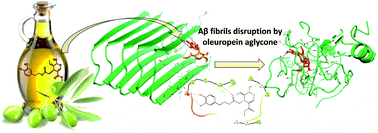Amyloid β fibril disruption by oleuropein aglycone: long-time molecular dynamics simulation to gain insight into the mechanism of action of this polyphenol from extra virgin olive oil†
Abstract
In the central nervous system (CNS), extra virgin olive oil (EVOO) produces interesting effects against neurodegenerative disorders including Alzheimer's disease (AD). The valuable properties of EVOO are largely ascribed to oleuropein aglycone (OA), its most abundant phenolic constituent. In particular, it has been demonstrated that in AD, OA produces strong neuroprotective effects being able to reduce amyloid β (Aβ) aggregates, thereby diminishing the related cytotoxicity and inflammation. OA prevents Aβ aggregation, but more importantly OA was able to disrupt the preformed Aβ fibrils. Herein, we describe a comprehensive computational investigation of the mechanism of action of OA as an Aβ fibril disruptor at the molecular level. We employed extensive molecular docking calculations and long-time molecular dynamics simulation for mimicking the system of OA/Aβ fibrils. The results showed that OA is able to move in depth within the Aβ fibrils targeting a key motif in Aβ peptide, known to be relevant for stabilizing the assembled fibrils. OA causes a structural instability of preformed Aβ fibrils, determining the effective Aβ fibril disaggregation. Accordingly, this study highlighted the role of OA as a potent anti-amyloidogenic drug. On the other hand, our work has relevant implications for rationally designing potent multifunctional compounds acting as disease modifying anti-Alzheimer's drugs for the development of innovative anti-AD therapeutics.



 Please wait while we load your content...
Please wait while we load your content...